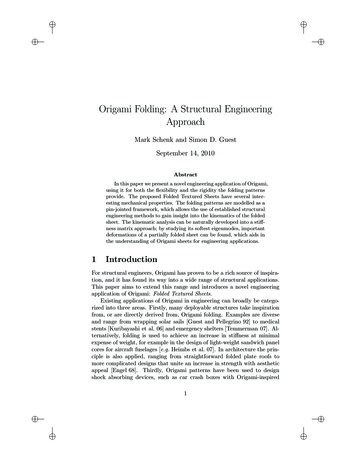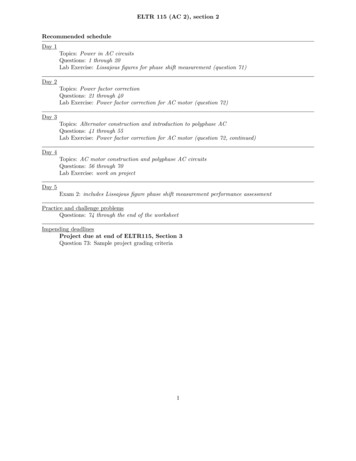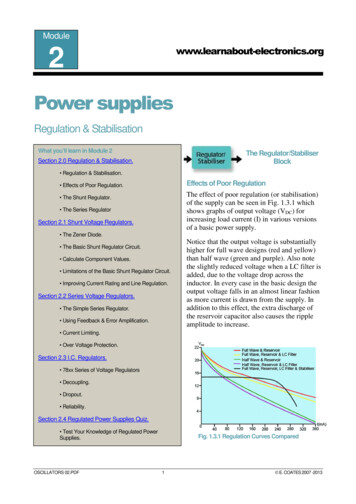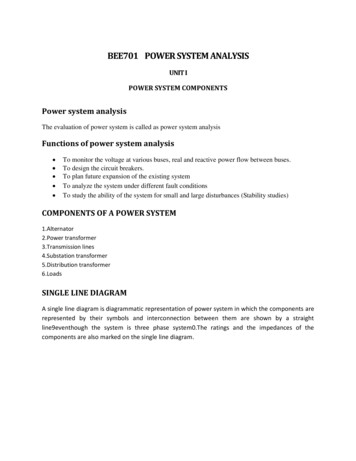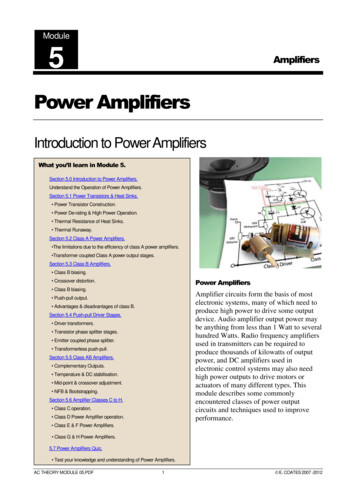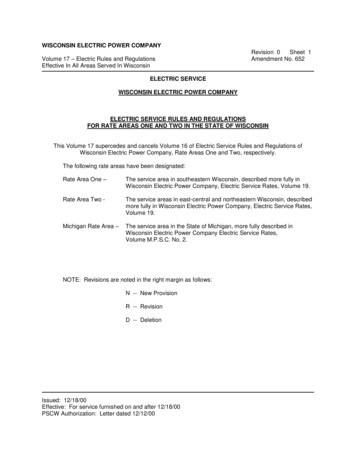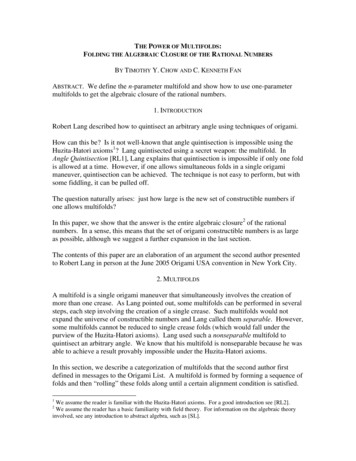
Transcription
THE POWER OF MULTIFOLDS:FOLDING THE ALGEBRAIC CLOSURE OF THE RATIONAL NUMBERSBY TIMOTHY Y. CHOW AND C. KENNETH FANABSTRACT. We define the n-parameter multifold and show how to use one-parametermultifolds to get the algebraic closure of the rational numbers.1. INTRODUCTIONRobert Lang described how to quintisect an arbitrary angle using techniques of origami.How can this be? Is it not well-known that angle quintisection is impossible using theHuzita-Hatori axioms1? Lang quintisected using a secret weapon: the multifold. InAngle Quintisection [RL1], Lang explains that quintisection is impossible if only one foldis allowed at a time. However, if one allows simultaneous folds in a single origamimaneuver, quintisection can be achieved. The technique is not easy to perform, but withsome fiddling, it can be pulled off.The question naturally arises: just how large is the new set of constructible numbers ifone allows multifolds?In this paper, we show that the answer is the entire algebraic closure2 of the rationalnumbers. In a sense, this means that the set of origami constructible numbers is as largeas possible, although we suggest a further expansion in the last section.The contents of this paper are an elaboration of an argument the second author presentedto Robert Lang in person at the June 2005 Origami USA convention in New York City.2. MULTIFOLDSA multifold is a single origami maneuver that simultaneously involves the creation ofmore than one crease. As Lang pointed out, some multifolds can be performed in severalsteps, each step involving the creation of a single crease. Such multifolds would notexpand the universe of constructible numbers and Lang called them separable. However,some multifolds cannot be reduced to single crease folds (which would fall under thepurview of the Huzita-Hatori axioms). Lang used such a nonseparable multifold toquintisect an arbitrary angle. We know that his multifold is nonseparable because he wasable to achieve a result provably impossible under the Huzita-Hatori axioms.In this section, we describe a categorization of multifolds that the second author firstdefined in messages to the Origami List. A multifold is formed by forming a sequence offolds and then “rolling” these folds along until a certain alignment condition is satisfied.1We assume the reader is familiar with the Huzita-Hatori axioms. For a good introduction see [RL2].We assume the reader has a basic familiarity with field theory. For information on the algebraic theoryinvolved, see any introduction to abstract algebra, such as [SL].2
2TIMOTHY Y. CHOW AND C. KENNETH FANWhen the alignment is attained, all creases are made sharp. The various configurations ofthe creases involved in the multifold can be parameterized by some number of variables.As the creases are rolled along, a path is traced in the parameter space. If n parametersare required to parameterize the creases in the multifold, we call the multifold an nparameter multifold.The casual reader may safely skip the more precise definition of an n-parameter multifoldthat we now give. Let Fk be a finite sequence of folds. Let nk be a sequence ofnonnegative integers and let n be the sum of the nk. Assume the following:1. The fold Fk can be specified in terms of a standard alignment (in the sense ofHuzita-Hatori) using any preexisting references and/or references created by priorfolds in the sequence and/or any nk real numbers that parameterize variablereferences. (Normally, these parameters correspond to measurable features of themodel, such as an angle or distance.)2. There exists a domain D in Euclidean n-dimensional space such that D is equal tothe closure of its interior and the map F from D to physical configurations of themodel (which includes creases) obtained by performing the sequence of folds Fkis continuous.3. The model can be physically manipulated in a continuous manner within theimage of F.Definition. An n-parameter multifold is the image, under F, of a point in D.In the context of origami constructions, only certain n-parameter multifolds F(d), where dis in D, are useful. Namely, F(d) must satisfy an alignment condition involving existingreferences (including references created by the folds in the folding sequence) that mustisolate the value of at least one parameter. When an alignment condition depends on onlym of the n parameters to isolate the value of the desired parameters, we will also call sucha multifold an m-parameter multifold. For example, let F1 be defined by a fold parallel toa fixed edge of a square sheet of origami paper and a parameter d that gives the distanceof the crease from that edge. Every d that specifies a crease within the origami squareyields a one-parameter multifold. However, it is useless as far as origami constructionsgo to allow any such multifold because most do not allow for d to be computed. In thisexample, the book fold, which is specified by an appropriate alignment condition, doesgive a constructive multifold.Also note that the third condition for the folding sequence makes any unfolding in thesequence risky. If the folding sequence involves unfolding a fold and refolding along acrease that intersects the unfolded crease, it is no longer possible to manipulate the modelcontinuously: to alter the first crease, the model would have to be refolded along adiscretely new location as opposed to having the new crease achieved by “rolling” theoriginal crease to a new position.There is a distinct practical advantage to using one-parameter multifolds. In a oneparameter multifold, one is guaranteed to discover the alignment condition by rolling the
POWER OF MULTIFOLDS3creases so long as one is in the same connected component as the alignment condition.However, in multi-parameter multifolds, one could fiddle endlessly with the paper in adesperate search for the alignment condition. The difference is similar to trying to locatea buoy in the Pacific Ocean using a telescope from an airplane by flying about with andwithout the benefit of knowing on which line of longitude the buoy bobs.The good news is that one-parameter multifolds suffice because the algebraic closure ofthe rational numbers can be constructed using one-parameter multifolds alone, that is:Theorem. Suppose that the complex number z is a root of a polynomial with rationalcoefficients. Then the real and imaginary parts of z can be constructed using oneparameter multifolds.We remark that Lang’s angle quintisection uses a one-parameter multifold.3. GETTING REALUsing well known facts about algebraic numbers, it suffices to show that we canconstruct only the real roots of polynomials with rational coefficients. Briefly, the reasonis that the algebraic closure of the rational numbers is closed under complex conjugation,addition, and multiplication. Because Re a (a ā)/2 and Im a –i(a – ā)/2, both thereal and imaginary parts of any algebraic number are algebraic.In fact, given an algebraic number z and a polynomial with rational coefficients p withp(z) 0, it is possible to construct polynomials with rational coefficients with the real andimaginary parts of z among their roots. This enables us to not only construct thealgebraic closure of the rational numbers in the abstract, but also enables us to solve forthe roots of any given polynomial with rational coefficients.4. THE SET UPSo, in accordance with Section 3, we are given a polynomial p(x) anxn an – 1xn – 1 a1x a0 with rational coefficients and we need to construct its real roots.At first, it might seem that one could simply pick x arbitrarily and use standardconstructions for addition and multiplication to construct p(x). Then, by varying x, find aroot by noting when the constructed p(x) is 0. The problem with such an approach is thatit may not be possible to continuously vary x because, for instance, the construction mayinvolve unfolding and refolding or other obstructions might arise3. For this reason, somecare must be taken to ensure that this does not happen.To describe the method of construction, it helps to forget about origami for a moment.Instead, let us imagine that we are working with an unlimited supply of rectangular sheetsof paper that can come with any dimensions that we desire. We will show how to find a3In fact, Robert Lang mentioned to the second author that just such an obstruction was preventing anapproach by him and Erik Demaine (using linkages) from working (as of the June, 2005 OUSA).
4TIMOTHY Y. CHOW AND C. KENNETH FANreal root of p using these sheets of paper and later show how to turn this into an origamimultifold.When we speak of using “large” or “long” sheets, by the way, what we mean is that somefinite sized sheets will work and if you try the construction and discover that you ran outof paper, it means you just have to try again with larger or longer sheets!So take a large square sheet and make a book fold through it. Unfold and orient it so thatthe resulting crease is vertical. We will refer to this as the zero crease. Please refer toFigure 1.FIGURE 1. The preliminary setup.Now, fold and unfold another sharp crease parallel to and one unit to the right of the zerocrease. Call this new crease the one crease.We shall assume that the polynomial is given to us by having rectangular strips withlengths equal to the absolute value of the coefficients. If you really want to, you canencode the sign of the coefficient by using one color for positive and another color fornegative.Next, fold the lower left corner of the square to the center to create a 45 crease in thelower left quadrant. Unfold. Call this crease the diagonal reference.Finally, take a very long thin rectangular sheet and place it on top of the square sheetparallel to the zero and one creases. Call this sheet x.Our multifold will be parameterized by the horizontal distance between the zero creaseand the left edge of sheet x. We shall also use x to refer to this distance.In the construction, we will often refer to horizontally, vertically, or diagonally alignedrectangles. Use the edges of the square or the diagonal reference to fix these orientations.
POWER OF MULTIFOLDS55. OVERVIEW OF THE CONSTRUCTIONThe idea behind our construction is to define a sequence of folds that depend on thesingle parameter x. Performing the folds ultimately results in a pair of edges separated bythe distance p(x). This sequence gives rise to a one-parameter multifold defined by thealignment condition that this pair of edges overlap, that is, by the condition that p(x) 0.In order to do this, write p(x) in the formp(x) x(x( (x(xan an – 1) an – 2) ) a1) a0.We devise a special sequence of folds that takes as input a pair of edges separated by thedistance d and outputs a pair of edges separated by the distance xd a, where a is a givenconstant. Using this special folding sequence, we can achieve a pair of edges separatedby the distance p(x) by working outward from the innermost embedded expression xan an – 1.In the next section, we shall describe this special sequence of folds.6. THE HEART OF THE CONSTRUCTIONOur construction will be achieved by repeated application of the following foldingsequence. Please refer to Figure 2.FIGURE 2. The input and output pairs of horizontal strips are solid black.We assume that we are given a quantity d encoded as the distance between the inneredges of two long, thin horizontal strips situated on the square sheet (the lower pair ofblack horizontal strips in Figure 2). If the quantity is positive, think of the lower strip as“locating zero”, otherwise, think of the upper strip as “locating zero”. When we refer to
6TIMOTHY Y. CHOW AND C. KENNETH FANthe “inner edge” of one of these long, thin horizontal strips, we shall mean “inner” in thecontext of the two strips forming a pair. Let Z denote the point of intersection of theinner edge of the strip locating zero and the zero crease.We aim to produce a new pair of long, thin horizontal strips that encode, in the samemanner, the quantity xd a where a is a real number given to us as the length of arectangle which we will call sheet a (just as the coefficients of the polynomial are givento us).To do this, note that the inner edges of the horizontal strips together with the zero and onecreases form the edges of a rectangle. Place the edge of a long, thin rectangular stripalong the diagonal of this rectangle so that it passes through Z. Follow the edge of thisrectangular strip to where it intersects the left edge of sheet x and mark this intersectionpoint by placing the top or bottom (whichever is easier to see) edge of an auxiliary long,thin horizontal strip through the intersection. The vertical distance between the relevantedge of this auxiliary strip and the inner edge of the given horizontal strip locating zero isxd. The relevant edge of the auxiliary strip will be above or below the given horizontalstrip locating zero depending on whether xd 0 or xd 0.Situate sheet a vertically above or below (depending on whether a 0 or a 0) therelevant edge of the auxiliary strip. Pick a place where sheet a will not obscure anyimportant existing intersections. Place another long, thin horizontal sheet so that its topedge is flush with the side of sheet a opposite the auxiliary strip. Let Y denote theintersection of the top edge of this last horizontal sheet and the zero crease.Points Z and Y are on the zero crease and are separated by a distance of xd a. We wantto encode this distance as the separation between a new pair of long, thin horizontal stripsin the same way that we were given d. To do this, take a pair of long, thin parallelrectangular strips so that their inner edges pass through Z and Y. Use the diagonalreference to orient these strips at a 45 angle. Place a vertical strip across this pair ofdiagonal strips in a location where, looking horizontally from the intersections, you havea clean part of the square sheet in which to work. (If you h
to Robert Lang in person at the June 2005 Origami USA convention in New York City. 2. MULTIFOLDS A multifold is a single origami maneuver that simultaneously involves the creation of more than one crease. As Lang pointed out, some multifolds can be performed in several steps, each step involving the creation of a single crease. Such multifolds would not expand the universe of constructible .

